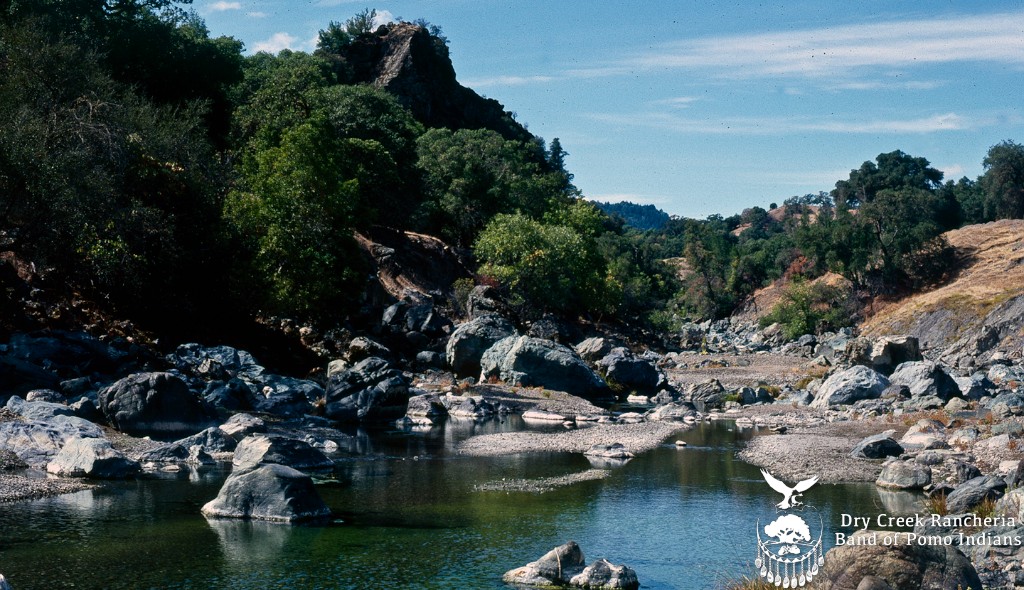
Dry Creek Before the Flood
June 19th. 2019 – Have you ever wondered what Dry Creek looked like before the flood and before Warm Springs Dam was built to create Lake Sonoma? Here we have an amazing gallery from our historical archives of what Dry Creek was like prior to 1982, when the Dam was completed. The vast profundity of cultural loss from this event can never be overstated, for all Pomo peoples, particularly the Dry Creek Rancheria Band of Pomo Indian’s. Our entire way of life was erased from the history books, as well as the vast amount of ancestral land that composed the old Dry Creek area. We are very happy to have discovered this photo record of Dry Creek and to be able to see the land in its former glory and to share it with you all!
Warm Springs Dam: A Story of Two Worlds
To most folks motoring up Dry Creek Road out of Healdsburg for the first time, the sight of Warm Springs Dam looming over the measured rows of grapevines at the far end of the valley provides a bit of a surprise.
That’s particularly true if they take what has become Skaggs Springs Road past the dam’s visitor center and hatchery to view the expansive lake pooled behind its massive, sloping walls. The blue waters seem to stretch to the horizon or at least to the green winter hills ringing the great impoundment.
Built of 30 million cubic yards of compacted earth fill with an impervious core, the 319-foot tall dam was completed in 1983. The reservoir drains 130 square miles of Dry Creek watershed and is capable of holding 381,000 acre-feet (124 billion gallons) of water.
The dam’s completion followed nearly 10 years of controversy, with opposition to the project fueled by fears the dam would spur further growth in the region and would eliminate hundreds of miles of steelhead and salmon spawning habitat in tributary streams that include Cherry, Yorty and Warm Springs creeks. Dry Creek is a major tributary to the Russian River.
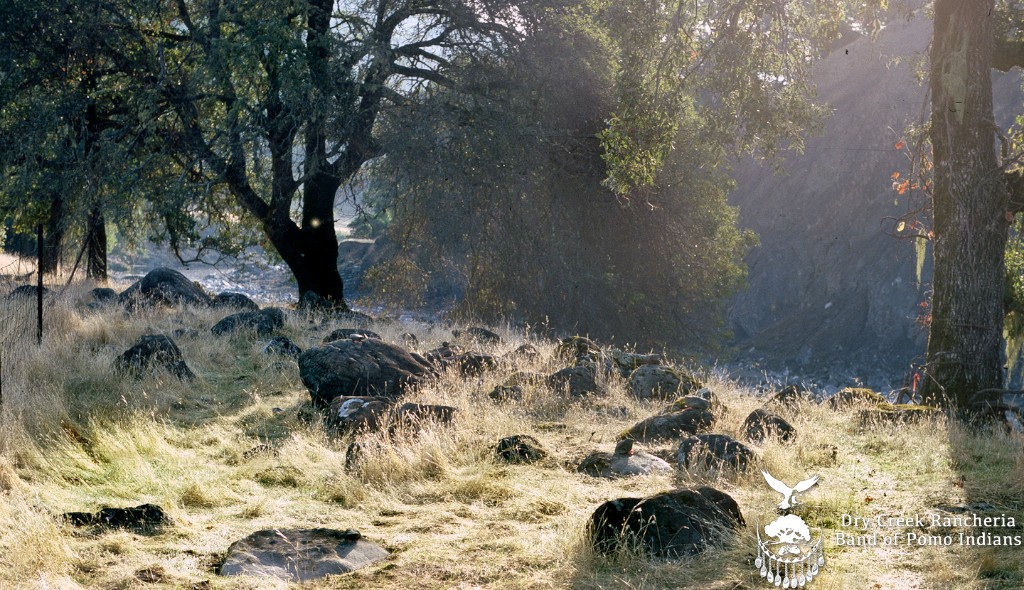
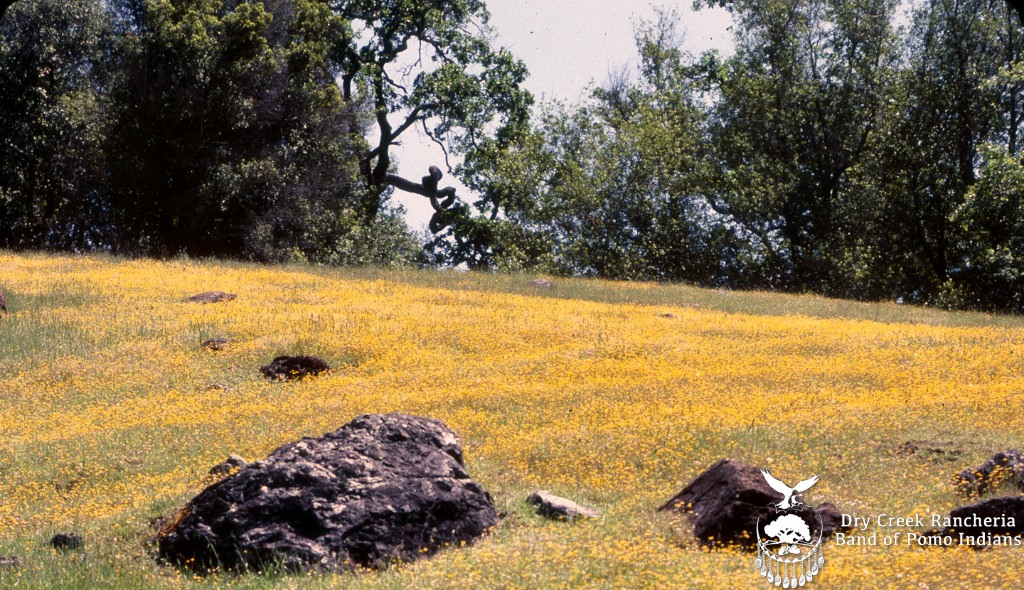
Under the Lake
The lake drowned not only many of the area’s 65 prehistoric and 45 historic indigenous Pomo sites but also miles of vegetation, including sedges, willow and other materials used to fabricate their intricately woven basketry, famous the world over.
The Dry Creek Valley area, some 8,765 acres extant, provided resources that supported various Pomo communities (and at the time of European contact, members of the Wappo people), living on land watered by an unfettered Dry Creek.
In addition to the fish and basket-making plants, the resources used by these people included acorns, pine nuts, pepperwood, toyon, manzanita, angelica and yerba santa as well as soap root and horsetail reeds, providing brushes and lathers for cleaning and personal use.
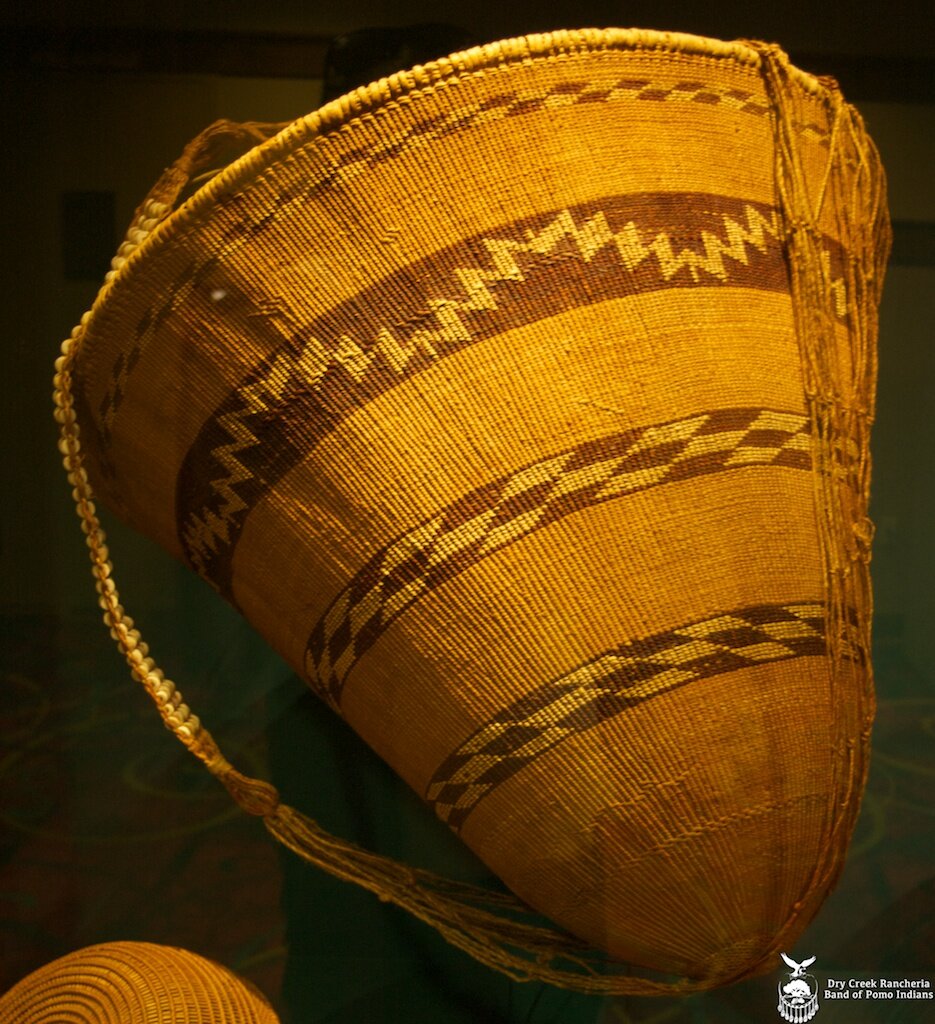
Under the Lake
Most visitors enjoying their jet skis, fishing boats and other pleasure craft don’t realize that the waters upon which they ply their craft cover an earlier world, one whose Native traditions and life ways stretch not just to the horizon but back more than 10,000 years. And over an even longer span of time, the spawning steelhead and salmon had been thriving here.
The lake drowned not only many of the area’s 65 prehistoric and 45 historic indigenous Pomo sites but also miles of vegetation, including sedges, willow and other materials used to fabricate their intricately woven basketry, famous the world over.
The Dry Creek Valley area, some 8,765 acres extant, provided resources that supported various Pomo communities (and at the time of European contact, members of the Wappo people), living on land watered by an unfettered Dry Creek.
In addition to the fish and basket-making plants, the resources used by these people included acorns, pine nuts, pepperwood, toyon, manzanita, angelica and yerba santa as well as soap root and horsetail reeds, providing brushes and lathers for cleaning and personal use.
Federal Hearings
Famed local basket weavers, including Elsie Allen, Mabel McKay, Lucy Smith, Laura Somersal and others, gathered sedge and willow from the Dry Creek Valley area to create fine Pomo baskets up until the time the waters of Lake Sonoma filled their harvesting spots.
Before the reservoir filled, the federal Corps of Engineers held a series of meetings with tribal members that included the above-mentioned basket weavers. The Corps agreed to try and relocate many of the plants. Sedge, willow, and angelica—considered to be a particularly sacred plant—would be moved downstream of the dam in order to preserve some of this precious resource.
Faced with no other choice, but doubtful the effort would work, the elders agreed to take part in the transplanting. This involved moving tens of thousands of plants that need specific soil and growing conditions—particularly sedge, the roots of which must grow in straight lengths if they are to be useful for basket making.
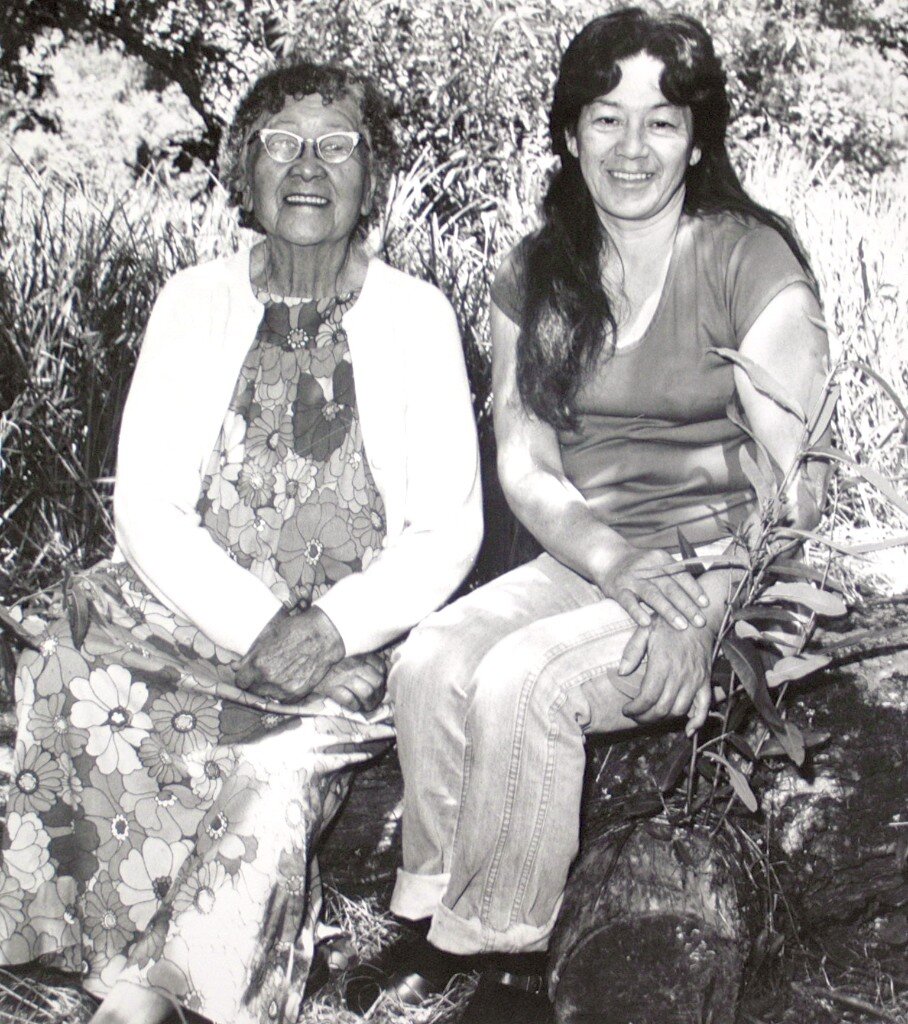
According to National Park Service records, Laura Somersal stated during the hearings, “We used to be able to gather sedge from the Warm Springs area. Because of the dam going in, we can’t do it anymore. They have replanted the sedge, but it will be three to five years before we’ll know if that will work. We haven’t been out since they bulldozed Dry Creek. There is just a little sedge left, way up above.”
Basket weaver Elsie Allen is quoted as saying back then, “Not all streamsides have the proper conditions for growing bulrushes and sedges. It is necessary to find places along streams where the current is not too swift, so that enough sandy soil has accumulated in low areas near the streamside to allow these plants to grow. You can come back every three years. This pruning of the sedge root in the ground is actually good for the plants preventing the roots from overusing the nutrients in the soil, and from growing into masses that are so hard on basket weaving diggers!”
“Digging for roots in the warm springtime,” she said, “gave a feeling of being part of the beautiful natural world…”
At the time (and possibly at present), many area Native people carried warnings from the elders that at some point, the dam will suffer a disastrous fate. This stems from the presence of several quake faults in the area and from the belief that drowning the land would create harmful spiritual karma.
Be that as it may, a couple of decades later, Reg Elgin—historic preservation officer for the Dry Creek Pomo Rancheria—says those transplanted sedges and willows are still very much on the minds of his people.
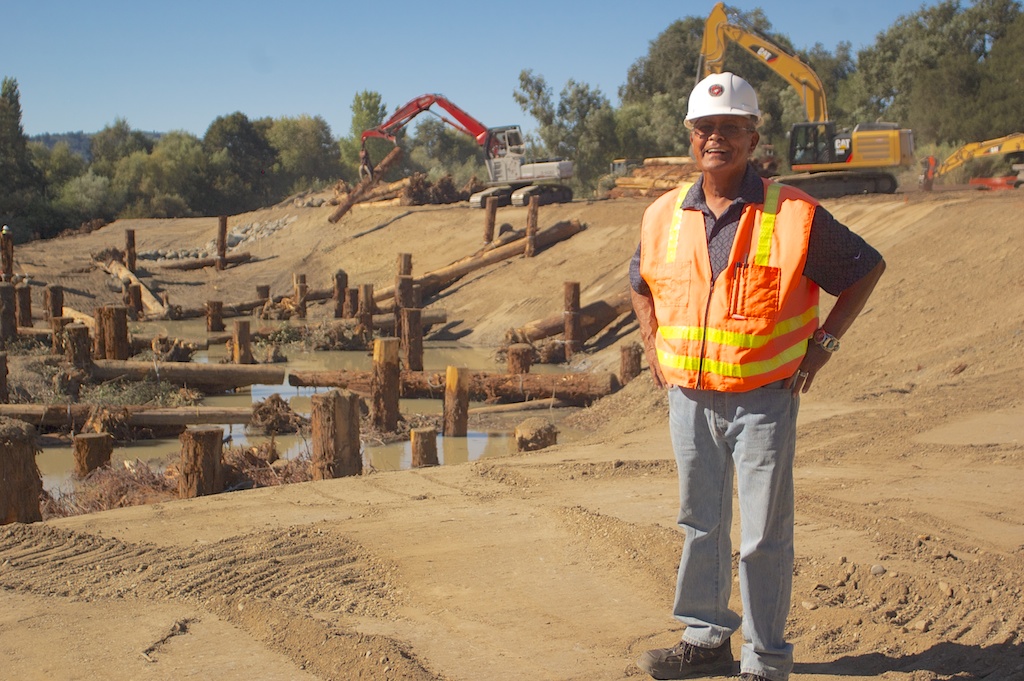
According to National Park Service records, Laura Somersal stated during the hearings, “We used to be able to gather sedge from the Warm Springs area. Because of the dam going in, we can’t do it anymore. They have replanted the sedge, but it will be three to five years before we’ll know if that will work. We haven’t been out since they bulldozed Dry Creek. There is just a little sedge left, way up above.”
Basket weaver Elsie Allen is quoted as saying back then, “Not all streamsides have the proper conditions for growing bulrushes and sedges. It is necessary to find places along streams where the current is not too swift, so that enough sandy soil has accumulated in low areas near the streamside to allow these plants to grow. You can come back every three years. This pruning of the sedge root in the ground is actually good for the plants preventing the roots from overusing the nutrients in the soil, and from growing into masses that are so hard on basket weaving diggers!”
“Digging for roots in the warm springtime,” she said, “gave a feeling of being part of the beautiful natural world…”
At the time (and possibly at present), many area Native people carried warnings from the elders that at some point, the dam will suffer a disastrous fate. This stems from the presence of several quake faults in the area and from the belief that drowning the land would create harmful spiritual karma.
Be that as it may, a couple of decades later, Reg Elgin—historic preservation officer for the Dry Creek Pomo Rancheria—says those transplanted sedges and willows are still very much on the minds of his people.
“In 1979, they transplanted 39,000 plants,” he said. “And we’re not going to really disturb them. Very recently, though, in the last two or three years, we’ve been in dealings with the Army Corps. One thing they want us to do is to weed and prune them; they are overrun with ivy and poison oak, but some are doing well.”
Elgin said although many of the elders in the tribe are too elderly to actually go out and gather, “We are still taking a pretty active role in watching the nine areas that were transplanted and actually putting
on basket weaving classes using some of
the material.”
Elgin also said, in light of the increased recent interest in the transplant areas, “we have been up and down the lake and we have hired an ethnobotanist to map areas of importance for us.”
In fact, Elgin said that early on, a number of Native American advocacy groups had suggested that Lake Sonoma be named Lake Pomo. “They promised to name it after the Indians, but didn’t.”
“They took 88,000 acres of tribal land from Native people,” he said, “17,000 acres of which are underwater. We got 75 acres; I don’t think that’s even. There are 26 known sites and they gave us 10 acres for the sedge plants.”
“We’re thinking that we would like to take it back,” he added, “Then it would be Lake Pomo after all.”
